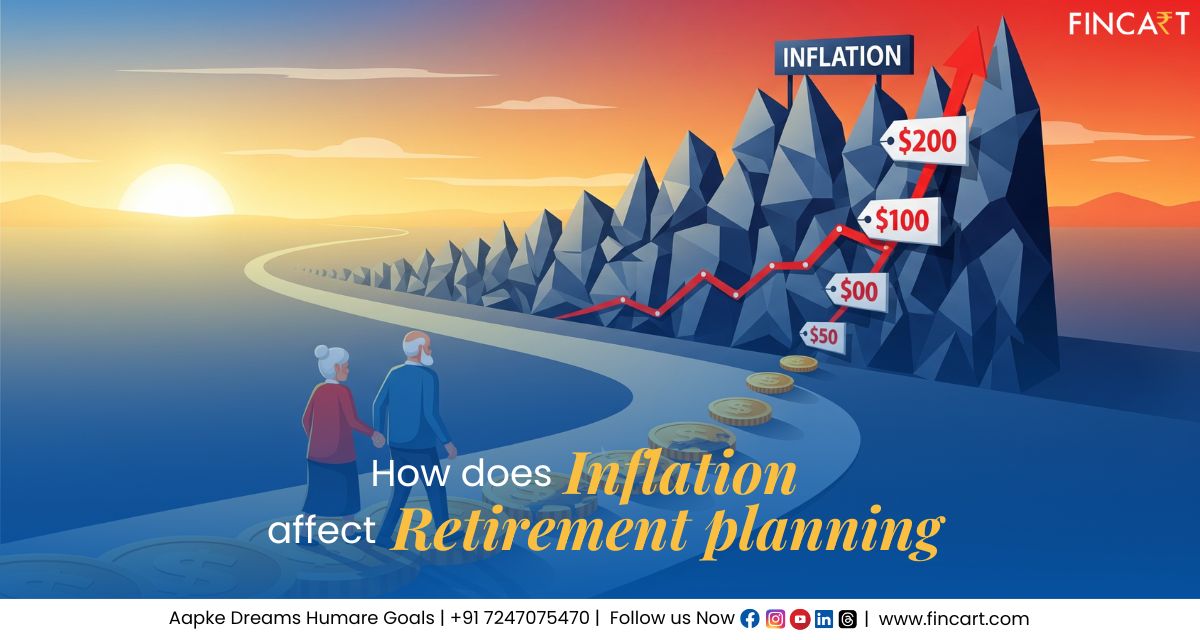Why the Silent Wealth-Killer Deserves Your Attention
Imagine this: You’ve worked for 30+ years, saved diligently, and built a ₹1 crore retirement corpus. You finally retire — ready to travel, relax, and enjoy the life you dreamed of. But five, ten, fifteen years later, you realize your comfortable monthly expenses now feel tight. Your savings don’t stretch as far as they used to and the question remains- How Does Inflation Affect Retirement Planning?
What happened?
Inflation happened.
In this blog, we’ll explore how does inflation affect retirement planning, why it’s one of the biggest threats to your post-retirement security, and what you can do to protect your hard-earned wealth.
What Is Inflation and Why Should Retirees Care?
Inflation is the gradual increase in prices over time, reducing the purchasing power of money.
Consider this:
- At 6% annual inflation, ₹1 lakh today will need about ₹2 lakh in 12 years to maintain the same lifestyle.
- Your savings may appear adequate now, but without adjusting for inflation, they could fall short of covering future expenses.
For retirees, the danger is silent but relentless. Ignoring it can turn a comfortable retirement into a financially stressful one.
The Safety-First Mindset — and Its Pitfall
Many retirees believe the safest approach is to exit equities entirely and rely on debt instruments like fixed deposits and bonds.
Goal: Avoid market volatility and protect capital.
Reality: Debt returns often grow slower than inflation. Over time, your savings lose purchasing power, meaning your money doesn’t stretch as far as you planned.
The Pitfall: This instinctively safe approach can backfire. Retirees who rely solely on debt may find their corpus depleting faster, potentially outliving their savings — especially during longer retirements.
Why 100% Debt Can Be Riskier Than You Think
Debt instruments feel safe because of predictable returns. But when considering how inflation affects retirement planning, relying solely on debt can be risky:
Fixed returns < Inflation: If your debt investments yield 6% but inflation is also 6%, your money isn’t really growing — its purchasing power stays the same, meaning your lifestyle could become harder to maintain over time.
Corpus depletion: As inflation increases your expenses, you have to withdraw from your principal sooner, which shortens the life of your retirement corpus.
Example:
- Retirement corpus: ₹1 crore
- Monthly expenses: ₹1 lakh
- Debt return: 6%
- Inflation: 6%
Even with disciplined withdrawals, your savings may last only about 17 years, leaving your later retirement years financially uncertain.
Equity: The Inflation Hedge You Can’t Ignore
Equities often get a “risky” label, but historically, they outperform inflation over the long term.
- Equity provides growth potential, helping your corpus maintain purchasing power.
- The goal in retirement isn’t to chase high returns but to manage risk smartly.
Balancing equity and debt can extend the life of your savings and ensure you can sustain your lifestyle without panic withdrawals.
Balanced Portfolio Scenarios
A well-structured portfolio is crucial for protecting your retirement savings from inflation while ensuring your corpus lasts longer. The key is to maintain a balance between growth (equity) and stability (debt).
Here’s a practical look at how different allocations can impact your retirement corpus:
| Scenario | Equity % | Debt % | Expected Corpus Life* |
| Conservative | 30% | 70% | ~23 years |
| Balanced | 50% | 50% | ~27–28 years |
| Aggressive | 70% | 30% | ~30+ years |
Assumptions: 6% inflation, 10% equity returns, 6% debt returns, systematic withdrawals.
Even a modest 30% equity allocation can extend your financial security by around 6 extra years compared to staying fully in debt. As equity exposure increases, your portfolio has more potential to outpace inflation, helping you maintain your lifestyle throughout retirement.
How Inflation Shapes Retirement Decisions
Inflation influences nearly every aspect of post-retirement planning. Understanding its impact helps you make smarter decisions:
- Withdrawal Strategy: As prices rise, you may need to withdraw more money each year to maintain your lifestyle. Without planning, this can shorten the life of your savings.
- Investment Allocation: Relying solely on debt can leave you vulnerable to inflation. Keeping some growth assets like equity is essential to protect purchasing power.
- Healthcare Costs: Medical expenses often increase faster than general inflation, making it crucial to plan for rising healthcare needs.
- Lifestyle Choices: Retirement dreams — from travel to hobbies — may require inflation-adjusted budgeting, so your corpus can support the lifestyle you envision.
Finding the Right Balance for You
Every retiree has a unique situation, so the ideal portfolio allocation depends on several factors — especially when considering how does inflation affect retirement planning:
- Risk Tolerance: How comfortable you are with market ups and downs will determine how much equity you can hold without stress.
- Essential vs. Discretionary Expenses: Distinguish between fixed obligations (like bills and healthcare) and lifestyle desires (like travel or hobbies) to decide how much risk your portfolio can take.
- Additional Income Sources: Pensions, annuities, rental income, or part-time earnings can reduce reliance on your corpus and allow for a slightly higher equity allocation.
- Longevity Expectations: Planning for a retirement that could last 25–30 years ensures your money lasts throughout your lifetime.
Practical Approach: Maintaining 20–40% in equity, rebalancing annually, and adjusting allocations with age can help you manage risk while keeping your portfolio aligned with your long-term goals.
The Mindset Shift: From “Avoid Risk” to “Manage Risk”
Retirement isn’t about stopping investing — it’s about strategic investing.
- Plan withdrawals based on inflation-adjusted projections.
- Focus on long-term sustainability rather than short-term market movements.
- Embrace periodic portfolio reviews to adapt to market changes and evolving expenses.
This mindset helps you stay financially confident, even during market turbulence.
How Fincart Helps You Build Inflation-Proof Retirement Plans
At Fincart, we specialize in retirement-specific portfolio planning that protects against inflation:
- Customized Allocation: Tailored mix of equity, debt, and other instruments based on your profile.
- Inflation-Adjusted Goal Tracking: Realistic projections show how your corpus can last decades.
- Ongoing Monitoring & Rebalancing: Ensures your portfolio stays aligned with changing market conditions.
- Guidance Through Volatility: Emotional decisions can harm your plan; our advisors provide calm, data-driven guidance.
With Fincart, you’re not just saving for retirement — you’re planning to live your retirement with financial freedom.
Action Steps to Beat Inflation in Retirement
- Assess Your Corpus: Understand how long your current savings will last under expected inflation.
- Determine Your Risk Comfort: Identify how much market volatility you can tolerate.
- Allocate Strategically: Maintain a balanced equity-debt mix to sustain purchasing power.
- Plan for Healthcare & Contingencies: Include medical inflation in projections.
- Review Periodically: Adjust allocations and withdrawals as life circumstances and markets change.
Key Takeaways
- Inflation erodes retirement savings silently; ignoring it is risky.
- 100% debt may feel safe but can shorten your corpus life.
- Equity is a critical tool to outpace inflation and sustain lifestyle.
- A balanced portfolio, inflation-adjusted withdrawals, and ongoing monitoring are essential.
Fincart helps retirees build resilient, inflation-beating portfolios for financial freedom.




